 |
By Greg Hupé
(Meteorite Magazine, August 2002)
|
|
Planetary meteorites! These were the objects of the lofty goal set by my brother, Adam, and I
during the summer of 2001. We have always been goal-oriented individuals, with a huge amount
of energy and even more determination.
The experience we had in meteorite hunting consisted mainly of being “arm-chair” treasure
hunters, financing other individuals’ expeditions to Morocco. One of these trips produced the
now-famous lunar meteorite, NWA 482 ( see www.LunarRock.com ). On yet another one of these
investment opportunities, I was able to join the team and gained valuable insight into some
of the methods required to work with the Moroccans.
After several investment trips, we decided it was time to venture out on our own. Adam and
I put together a plan that would require finding a partner in Morocco. He would be our
“point man” who would find the potential meteorites we sought and ship them to us. The first
task was finding an honest dealer in Morocco.
Using the Internet and good old-fashioned telephone, we soon established our first partnership.
This proved to be a challenging ordeal that only lasted four months. After spending a
substantial amount of money and suffering through many sleepless nights, we ended this
arrangement. It quickly became apparent this “partner” was a con artist and a very good one!
Determined more than ever to succeed, we didn’t let this situation deter us.
Before we could establish a new partnership in Morocco, we attended the Tucson Gem and Mineral
show in February 2002. Here Adam and I finalized the purchase of a unique orthopyroxene-bearing
Nakhlite. This Martian meteorite was rumored to exist in Morocco as early as September 2001.
The dealers from whom we purchased this stone took the rumor seriously and played a key role in
its acquisition. We were invited into the pursuit of this mysterious stone because of its
extremely high asking price, although we held little hope that it actually existed. Once the
rumor was proved true, the deal was struck. This Nakhlite was given the provisional name NWA 998.
Once back from Tucson, we put together a new partnership with two other Moroccans named Akmed
and Yousef. Akmed does not speak English, so Yousef would serve as our translator. We decided
to set up this partnership more like a business in order to manage Akmed and keep track of
where each specimen came from. We taught
|
Akmed what to look for by describing the
characteristics of existing Martian and lunar meteorites in great detail. We also went as far
as insisting that we receive the potential meteorites before making any payments.
Within the first three packages, we had received everything from Howardites, Eucrites, LL’s and
even CR’s. Excitement was starting to build.
Later, a package arrived that held a 50-gram stone with no fusion crust, which caught
Adam’s attention. After weighing the stone, Adam cut it and was delighted by the weathering
ring and texture he saw on the inside. He said, “I’ll give this an 80 percent chance of being
a Shergottite”. The next day a thin section was prepared at the University of Washington and
revealed the characteristic presence of maskelynite, determining it was a Shergottite.
|
|

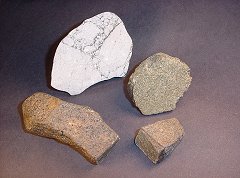
NWA 482 (top), NWA 998 (right), NWA 1195 (bottom).
|
Adam and I let out a jubilant, “Yahoo!”, and did the celebratory “high-five”.
Full electron microprobe analysis was later performed and confirmed the results of the thin
section. This was our first planetary meteorite and we had reached our goal after only eight
months. The new Martian meteorite was given the provisional name NWA 1195.
Since we insisted on detailed notes as to where each stone originated (and by which nomadic
group), a search was initiated in the Safsaf region where the 50-gram stone was found.
Within a week, another 265-gram stone was located 15 meters from the first site. Using
Yousef to translate, Akmed insisted it would “glue” to the 50-gram stone,
“like it had broke from it”. He sent a photo by email that looked very promising. We sent
payment for the stone so he could pay the nomad who found it and within four days it was
in Akmed’s possession.
We asked him to send us the 265-gram stone but he refused, saying he knew it was too valuable
to send in the mail. I tried to encourage him to send it but all I heard were horror stories
of lost packages. Akmed insisted we would have to fly to Morocco to retrieve the stone. I felt
we would not receive this Martian meteorite unless we went.
It was decided I would go to Morocco to retrieve the second piece of the new Martian stone
because I had been there before, and without hesitation, I enthusiastically agreed to embark
on the trip.
Before leaving, Adam and I decided I should take the cut end from the 50-gram stone that
appeared it would fit to the larger 265-gram half. This way I could see if the two halves
would truly “glue” together as promised by Akmed. We also felt it would be best to have a
code phrase I could call Adam with once I saw that the end cut would fit with the other
stone. This way I would not appear too eager to take possession of the prize in front of
Akmed. We did not want the possibility of losing this Martian meteorite to a partner’s
potential greed as had happened in a previous arrangement. Details all set, we were ready.
Starting in Seattle, the trip would take a grueling 36 hours and four different sleepless
stops just to reach my final destination in Ouarzazate, Morocco. While in Casablanca, I
endured an eight-hour layover at the airport with no sleep. I did not want to risk taking
a nap at the airport as I was carrying a large amount of cash, not to mention my carry-on
luggage that contained all of the tools I would need while in Morocco. We had heard
stories of other people being mugged while in their travels.
After drinking about $100.00 worth of Moroccan coffee to stay awake, not only was I in a
foreign land, I felt like I was flying in outer space! The next and final leg of the journey
was a quick 45-minute hop to Ouarzazate. Upon arriving, the local time was 12 o’clock midnight.
Akmed and Yousef were waiting at the gate, both of who were grinning ear to ear. This was the
first time I had met either man in person, and they each gave me a “bear hug” and kissed both
sides of my face, twice. This is a Moroccan tradition shared with good friends.
We left the terminal and headed to the four-wheel drive Land Rover parked outside. Akmed asked
me if I wanted to check into a hotel to get some rest after my long trip, but I said we should
head straight for Zagora to save time the next day.
Akmed, taking this as a sign to do business, drove me to a house no more than 10 minutes from
the airport. I was led into a dimly lit room where I was greeted by four rough looking Moroccans
sitting on the floor around a large round table. Several large boxes filled with meteorites
where haphazardly stacked against a far wall. The furniture was about half as tall as I was
used to. It is customary for Moroccans to sit on the ground covered with large rugs and lean
against pillows.
Even though it was late, one of the men brought out a large brass tray carrying a teapot, several
small glasses and a bunch of mint leaves. He also had a butane burner and a toolbox with a huge
brick of solid sugar in it. As the water was being brought to a boil, he used a wrench to break
off manageable pieces of the sugar. Once the water came to a steady boil, he added a large
handful of mint leaves and many large chunks of sugar.
While the tea was brewing, another man brought out a bowl overflowing with almonds and roasted
bread snacks. The man making the tea began to pour the brew out of the pot in a high arching
motion into one of the glasses. After repeating this process several times, he sampled it and
determined that it was ready to drink. He poured the first glass and offered it to me since I
was their honored guest.
After two hours of searching the boxes filled with stones, I set aside several kilos of
meteorites to purchase on my return from the desert. With Yousef’s assistance, I negotiated
with one man named Mohamed, while the others sat back on their pillows watching the spectacle.
We made arrangements to meet him in four days so we could settle the account.
Akmed, Yousef and I left into the middle of the night, heading for Zagora through the Atlas
Mountains. Three hours later, about 5:00am, we arrived at our destination, Akmed’s house. It
was a simple one-story mud brick structure with no running water. Without having to ask,
Akmed presented the brown and black 265-gram stone to me. Trying not to look excited, I held
the stone and thought that it looked just like the 50-gram Shergottite. I pulled out the end
cut from the 50-gram stone and placed it to the larger counterpart. I thought,
“They fit perfectly… just like a puzzle piece clicking into place!” I could barely hold my
emotions but knew I must because I did not want to risk losing the stone. I used Akmed’s
cellular phone to call Adam and said I had made the journey safely and then repeated our code
phrase we had agreed upon two days earlier, “The eagle has landed!” This meant that I had the
265-gram stone in my possession and that it was a perfect match. Adam, in Seattle, let out a
loud cheer, while I kept a straight face in front of Akmed and Yousef. I then hung up and was
ready for some sleep.
A few hours later I was awake and ready for business. After looking at some other beautiful
stones that Akmed had previously purchased for us, I wrapped them along with the 265-gram
Martian stone and packed them into my
|
|

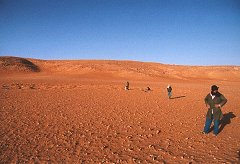
NWA 1110 ‘Mars-like’ strewnfield.
|
|
suitcase. We then sat down to an interesting breakfast,
which consisted of a very thick and chunky “orange juice” along with various fruits.
We were ready to head for the desert to meet different nomads on a three-day trip that would
take us far away from the small towns and villages that lined the Moroccan-Algerian border.
Akmed insisted that I should wear clothing similar to the local nomads since we would be
entering into the militarily patrolled “disputed zone” between Morocco and Algeria. He felt
I would be “safer”. This robe-type outfit is called a “jallaba”. This was topped off with a
“shesh”, a scarf-type length of cloth that wrapped around my head.
|
|
We traveled toward the area where NWA 1110, another Martian meteorite, was found several
months earlier. This region is called Maarir, a desolate
and dry area with crimson-colored
sand and rocks. It was a very fitting location for
|
|
a Martian meteorite to land as the area
looked just like the surface of the red planet.
On the way there Akmed picked up a friend
of his, a military officer, so he could be dropped off at his
station along the border. It is through this post
that we would gain access to the disputed zone. The officer decided he would join us to the
site. Once there, I recorded GPS coordinates and took photographs of the area including some
of the local nomads working the location. One industrious person was using an old motorcycle
fender as a scoop! With Yousef’s help, I was told that the nomads felt the site was
“finished” since hardly any more fragments were being found. This is the only reason I was
able to visit the area. One small piece was discovered while I was there,
|
|

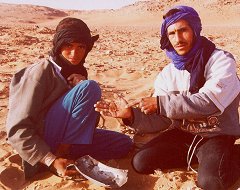
Berbers looking for pieces of Mars.
|
|
which I purchased along with a small cache of fragments the group had found the previous week.
We made our way back to the military checkpoint where we were stopped and held by the commander
in charge. There were several heated exchanges made by the commander, the officer and a couple
of other men at the post. After my passport
|
|

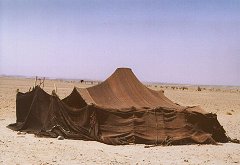
Traditional Berber tent in the Sahara.
|
|
and everybody else’s identification was taken by
the man in charge, Yousef informed me that the commander was furious with the guards on duty
for not documenting our credentials when we first went into the region and questioned why we
were there. I stated that I wished to document the location and photograph the process the
nomads used to retrieve the fragments. I was starting to get that “I’m toast” feeling! After
an hour, and more grilling by the commander, we were released and headed
north towards Safsaf to see if we could get in contact with the nomad who found the two
NWA 1195 Martian pieces.
We traveled for about two hours, driving slowly over rugged terrain that had little or no
vegetation. Akmed had expertly navigated us to the home
|
|
of a nomad family he knew. It was
a more permanent residence than the typical Berber tents many nomads live in. This family
had a mud brick dwelling complete with a small garden. We enjoyed their hospitality and
would stay the night. A meal of mint tea and “couscous” was served. It was a good dish
made of goat meat, vegetables and rice.
|
|
We ate this with pieces of bread, using our fingers.
The rest of the night was spent talking about a variety of worldly topics and telling 'desert riddles'
to pass the time.
Before we could call it a night, Akmed laid out a small carpet and bent to his knees.
With his head down and arms stretched out in front of him, he bowed up and down,
chanting in Arabic the whole time. This lasted for about five minutes and when he
was finished, it was time for “lights out”. Our sleeping quarters consisted of a
long narrow room, dimly lit, the floor covered with several layers of large rugs
serving as our beds for the night. Any other night
|
|

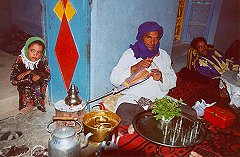
Making mint tea in Safsaf.
|
|
at home, these thin 'matresses'
would not come close to serving as a bed. If you are tired enough, you will sleep
on just about anything without a care!
The next morning, after looking at many suspected meteorites, we headed still
|
|

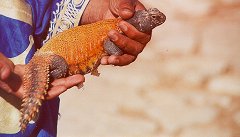
Colorful ‘Dab’ lizard from the Sahara.
|
|
deeper into the desert in to what seemed like no man’s land. The scenery was flat and barren
- an arid wasteland. Hour after hour, with numerous stops at nomad’s tents, we
traveled many kilometers. All of a sudden, Akmed slammed on the brakes of the Land
Rover and jumped out of the truck yelling in Arabic. I was wondering what the
commotion was all about when I saw Akmed pulling an animal out from under a rock.
It turned out to be a large orange lizard the locals call a “Dab”. I told them in
English, it is called a “lizard”. It was prehistoric looking with a huge belly,
scaly skin and a spiked tail. While Akmed was holding it, Yousef attempted to pet
the creature but
|
|
was quickly clubbed in the hand by the aggressive brute. To
Akmed’s amusement, Yousef ran off screaming in pain with blood trailing from his hand.
Yousef returned holding his injured appendage and said, at a respectful distance from the
reptile, “The ‘leeezard’ has good defense against me”. Akmed informed us that the
Dab was a meat eater and that if it bit a finger, he would have to cut it
off because the lizard has very sharp teeth and would not let go.
He decided we needed a mascot so he placed our new friend in the back of the four-wheel
drive with Yousef. Our frightened translator did not think this was a good idea but
reluctantly agreed. After we patched his wounds with a
|
|

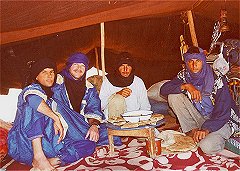
Lunch break in Berber tent.
|
makeshift bandage made from an
old tee shirt, we made our way deeper into the desert. Yousef kept his feet off the
floor the rest of the day. He said he didn’t want to get attacked by the vicious beast
lurking below him.
We traveled many hours and eventually found ourselves at the final stop of the day, a
Berber group’s black colored tent. This was open-sky living at its best.
We sat down to a late night meal, which consisted of mint tea and “tagine”; a dish made
with meat, vegetables and dates. Our hosts made sure I received the largest portions of
meat because I was their distinguished guest. Again we ate with our hands.
In the morning we looked at another cache of “meteorites”, most of which turned out to
be terrestrial rocks. Business accomplished, we were set for another eventful day in
the desert. Before entering the truck, Yousef said nervously, “Where is the ‘leeezard’
hiding”? He didn’t want a repeat of the previous day’s assault. He located his
archenemy hiding in the shadows of the truck’s floorboards and positioned himself
clear of our reptilian travel companion.
We drove over more of the same barren terrain. It was a flat nothingness as far as the
eye could see in all directions. After hours of this travel on a “road” that consisted
of only a faint pair of tire tracks, the area gave way to a small gorge that had an
oasis in it. This is where the small village of Safsaf is located. The inhabitants had
lush green gardens fed by a water source that had been discovered many centuries before.
It was truly amazing that they could survive out in the middle of the desert in such a way.
Akmed took us to the mud brick home of the man who found both halves of NWA 1195 but was
told he was in Algeria and would not be back for several days. It was agreed we would
stay the night there and then departed to meet with other villagers to see what material
they had. We acquired a few more excellent meteorites but most of the material turned
out to be very deceiving terrestrial rocks.
When we returned back to the earthen residence, we found that our hosts had butchered a
goat in our honor and would prepare goat-liver kabobs. These were made with cubes of
goat liver wrapped in stomach lining then put on a skewer and cooked over an open flame.
This was followed with mint tea and fruit.
After Akmed’s nightly prayer and having had a good night’s sleep, Yousef checked the
location of the “leeezard” in the Land Rover. We left early and headed for civilization,
back to Ouarzazate so I would be able to catch my 5:30 am flight the next morning.
It took all day and half the night to reach the outskirts of Ouarzazate. To Yousef’s
relief, this is where we decided to free our mascot. Akmed released the orange lizard
and we watched it disappear into the darkness of the night. Once in town, we checked
into a hotel and made arrangements to meet Mohamed, the man we met the first night. He
arrived 45 minutes later with several hundred pounds of meteorites and two helpers to
assist him with his burden. It took three hours to haggle over the bounty but several
more nice stones were acquired. We shook hands once a price was agreed upon and
settled our business.
After Mohamed and his two companions left, I carefully packaged the material, mindful
to leave the prized Shergottite out so I could hand carry it during my travels back to
the United States. I was not about to let it leave my possession after what I had gone
through to acquire it!
As there was not enough time for sleep, I quickly freshened up and was then whisked
away to the airport where I boarded my plane for Paris by way of Casablanca. I would
have to wait until the next morning for my flight to the States. This allowed me time
to catch up on some well-deserved sleep. The next day’s flights were on time and uneventful.
Once in Seattle, the 265-gram half of NWA 1195 was reunited with its 50-gram
counterpart after having weathered separately for thousands of years in the Sahara
Desert. Everybody involved was overjoyed by the success of the expedition. Not only
did Adam and I achieve a dream of finding a planetary piece we also brought together
a whole Martian meteorite. We made a mold of both halves, forever capturing the
shape of this fantastic meteorite.
Generous portions of both NWA 998 and NWA 1195 have been donated to the scientific
community for future study. A small amount of each meteorite will be made available
to private collectors. Not only will this allow private collectors access to these
wonderful new meteorites, it will help to offset the enormous costs involved in
obtaining these rare specimens.
Adam and I set a goal to find a planetary meteorite and far surpassed it. It was a
meteorite hunter’s dream come true.
|
|











